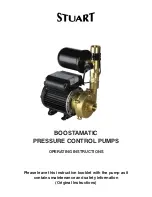
E-6
English
4.2
Important information:
To prevent contamination of the device and the heat ex-
changer, suitable exhaust air filters must be fitted in the air
duct system.
The exhaust air duct system must always be insulated with
water-proof insulation on the outside to prevent heat losses
and the formation of condensation when the system is
routed through rooms (e.g. attics, cellars, etc.) that are
colder than the extracted exhaust air.
(0.6 m maintenance and service clearance around the entire de-
vice)
4.2 Set-Up
Remove the three M12 transport restraint screws which fix
the unit to the pallet.
Remove pallet and install the three M12 supporting feet (in
plastic bag attached to the cylinder barrel nipple).
Position the HW HP and align
vertically
by adjusting the de-
vice feet! Then tighten the counternuts on the device feet.
5 Installation
5.1 Connecting the Water Pipes
The nominal pipe widths for the on-site sanitary installation must
be determined by taking into account the available water pres-
sure and any pressure drops expected to occur in the pipework.
The water pipes must be
installed
according to DIN 1988 (see
Appendix – for example, a pressure reducing valve must be used
if the pressure in the water pipes is impermissibly high!)
Both rigid and flexible water pipes may be used. Observe the cor-
rosion behaviour of the pipework materials to avoid corrosion
damage (see the Chapter “Start-Up”).
ATTENTION!
When installing the on-site pipework, ensure that the pipes are not
contaminated (flush pipes before connecting HW HP)!
5.2 Connecting the Condensed
Water Pipe
The condensed water hose is fed through the foil cladding at the
rear of the device. It should be so routed that the condensate
produced during heat pump operation can drain freely.
There is a pressureless seal valve on the condensed water hose
that must
be relocated
if the condensed water hose is shortened
(the valve can be easily removed and relocated on the hose).
This valve is of special importance if longer air hoses are fitted to
the device, or if a filter is installed upstream on the exhaust air
side. The condensate should be drained into a siphon (see also
the maintenance information in Section 7.1).
5.3 Electrical Connection
The HW HP is wired ready for use; power is supplied via connec-
tion cables plugged into an earthed wall socket (~230 V, 50 Hz).
This socket must remain accessible after installation.
To connect the remote control, a separate cable (6-pole with a
min. wire cross-section of 0.75 mm
2
and a max. external cable
cross-section of 13 mm) must be connected to the device and
strain relieved via a screwed cable gland provided for this pur-
pose.
Another separate cable has to be connected to the device to con-
trol external devices for the second heat generator (only in the
case of HW HP with internal heat exchangers). The electrical
connection terminal (X1 – 9/10/PE) with floating contact to con-
trol (ON/OFF) the external ancillary devices (pump, solenoid
valve, etc.) is located on the partition in the device. The external
supply leads must then be led through the provided cable
feedthrough, and guided through the partition. The plastic cover
of the HW HP has to be removed to connect these cables.
$SSUR[P
P
([KDXVWDLU
2XWJRLQJ
DLU
Содержание LBW 300
Страница 2: ......
















































